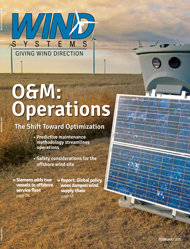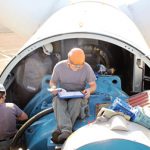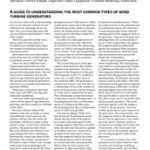Man and materials must regularly overcome around 90 meters in height to access the nacelles of offshore wind turbines for installation, maintenance and servicing activities. Lifting equipment, service lifts and ladders assist in carrying workers, equipment and heavy components. But what about occupational health and safety?
Lifting and material-handling equipment are used not only onshore for heavy-duty work. They also play a significant part in the installation, servicing, and maintenance of offshore wind turbines far out to sea. To cope with these tasks, all wind turbines nowadays come with cutting-edge lifting and material-handling equipment. However, the environmental, ambient and operating conditions involve specific risks, thus imposing very special requirements on components and occupational health and safety. Workers must be able to get safely from the service boats to the nacelle while safely moving loads that are often very heavy.
In concrete terms this means that workers at sea must be able to safely transport, say, a hydraulic cylinder with a weight of around 600 kg, even with the boat rocking in high waves, the entire tower oscillating in the wind and the loads swinging from the suspension hook. These conditions involve increased danger of impact and crush hazards because even the firm footing required by accident prevention regulations for manual lifting of even lighter loads of up to 25 kilograms cannot be guaranteed.
Challenges in Operation
The main dangers are not caused by the installed lifting equipment, service lifts and ladders themselves, which are all state-of-the-art. Rather, practical experience has shown that more attention should be paid at the planning stage to the different conditions for offshore wind turbines compared to the onshore sector, with a view to optimizing transport processes and improving safety levels.
One example concerns a lift’s long trailing cables and power lines. In an offshore wind turbine these cables do not simply hang vertically, but follow the oscillations of the tower. During operations, these cables may become entangled around ladders or get caught on components, causing hazards for the lift. The trolleys of the lifting equipment are a further example; unless they are restrained by braking and locking mechanisms, acceleration forces will cause them to move unexpectedly in their guide rails
Safe passage from service boat to nacelle
A further safety-relevant aspect has emerged during the operating life of the first offshore wind farms: there is also room for improvement in the systematic interaction between individual lifting devices and components, which should become a focus as early as the planning stage. Ideally, there should be a continuous transport chain for lifting heavy parts and components from the boat to the nacelle. Often, however, the transport chain is already interrupted at the entry to the tower, because the crane boom is too short to bridge the entire distance at the base and there are no robust and suitably marked anchorage points to transfer the load. The workers, who must find a solution under constant time and cost pressure, are forced to rely on their resourcefulness and talent for improvisation and sometimes resort to very risky and dangerous maneuvers to move the loads manually. The same phenomenon can be observed during many activities in the nacelle, where the narrow confines and the strong oscillations of the tower expose workers to even higher risks.
In recent years the industry has taken a greater interest in these issues and incorporated many aspects in current planning and design as lessons learned – not least because improved health and safety also offers potential to reduce operating costs. After all, well thought-out and smooth transport processes not only reduce the accident risk, but also considerably speed up work at the turbine; the risk-fraught scenarios described above are generally unnecessarily time-consuming or may even require temporary shutdowns. The cost-intensive mooring times of service boats are reduced significantly and the teams can complete more work more safely in the same period. Ultimately, then, optimization of transport processes at the turbine is a key factor in continuing the improvement of competitiveness of offshore technology and reducing the costs of power generation.
Optimized transport processes cut operating costs
In other areas too, pioneering work is being performed by those involved. The wind energy industry only moved into offshore operations around a decade ago; for this reason, the standards involved in this new industry sector must undergo continuous advancement and are regularly reviewed for this purpose. Recent years have shown that the mature technology generally installed in offshore operations, while eminently suitable for onshore service, required improvements before it could be used at sea. One such improvement is anti-corrosion coating to provide protection against the aggressive weathering of the salt-laden sea air. This also impacts significantly on transport processes, because adequate corrosion protection can ensure that lifting equipment and its components, such as brakes and gears, permanently function correctly and reliably — and thus guarantee their safety.
The shipbuilding and oil and gas industries apply stricter standards based on decades of experience with offshore conditions. However, their implementation would involve significantly increased costs. While these standards apply to far harsher conditions and it is unnecessary to adopt them unchanged, in many cases they can serve as a useful basis for alignment with the requirements of the offshore wind power industry, which are not reflected by their onshore counterparts
Conclusion and outlook
In recent years the offshore wind energy industry has made enormous technological strides in solving the challenges posed by operations at sea. Practical experience has shown that the design and structural integrity of the turbines, the transport and installation of large-size components and turbine technology can all be mastered – but it also reveals that transport processes involved in the installation, maintenance and repair of the turbines can be optimized and improved from the perspective of safety.
Many of these safety-relevant aspects have only become apparent during operation of the wind turbines. Given this, the time has come to address occupational health and safety and transport-process optimization in this context with more intensity. For example, hazard assessments performed during the planning phase can help to ensure that the components chosen are designed for safe offshore operation with respect to both ambient conditions and to potential situations arising during work on an offshore site.
— Source: TÜV SÜD Industrie Service






































